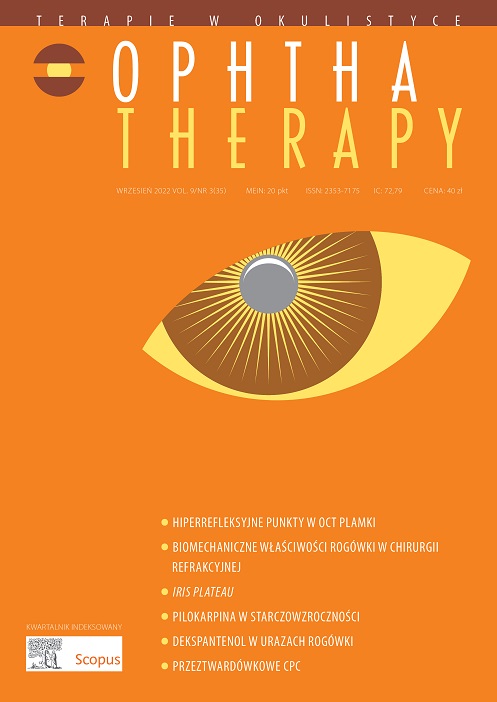Hyperreflective dots in optical coherence tomography Review article
Main Article Content
Abstract
Optical coherence tomography is a non-invasive and repeatable imaging method of posterior segment of the eye used in medical practice. Hyperreflective dots visible in OCT scans have been reported in various retinal diseases such as age-related macular degeneration, diabetic macular edema, retinal vein occlusion and central serous chorioretinopathy. In the future, HRDs may become a useful biomarker in making treatment decision and monitoring ocular conditions among the patients with mentioned diseases.
Downloads
Article Details

This work is licensed under a Creative Commons Attribution-NonCommercial-NoDerivatives 4.0 International License.
Copyright: © Medical Education sp. z o.o. License allowing third parties to copy and redistribute the material in any medium or format and to remix, transform, and build upon the material, provided the original work is properly cited and states its license.
Address reprint requests to: Medical Education, Marcin Kuźma (marcin.kuzma@mededu.pl)
References
2. Turgut B, Yildirim H. The causes of hyperreflective dots in optical coherence tomography excluding diabetic macular edema and retinal venous occlusion§. Open Ophthalmol J. 2015; 9: 36-40. http://doi.org/10.2174/1874364101509010036.
3. Coscas G, Coscas F, Vismara S et al. Clinical features and natural history of AMD. In: Coscas G, Coscas F, Vismara S et al (ed). Optical Coherence Tomography in Age-Realated Macular Degeneration. Heidelberg, Springer, 2009: 171-4.
4. Metrangolo C, Donati S, Mazzola M et al. OCT Biomarkers in Neovascular Age-Related Macular Degeneration: A Narrative Review. J Ophthalmol. 2021; 2021: 9994098. http://doi.org/10.1155/2021/9994098.
5. Curcio CA, Zanzottera EC, Ach T et al. Activated Retinal Pigment Epithelium, an Optical Coherence Tomography Biomarker for Progression in Age-Related Macular Degeneration. Invest Ophthalmol Vis Sci. 2017; 58(6): BIO211-BIO226. http://doi.org/10.1167/iovs.17-21872.
6. Altay L, Scholz P, Schick T et al. Association of Hyperreflective Foci Present in Early Forms of Age-Related Macular Degeneration With Known Age-Related Macular Degeneration Risk Polymorphisms. Invest Ophthalmol Vis Sci. 2016; 57(10): 4315-20. http://doi.org/10.1167/iovs.15-18855.
7. Heußen F, Ouyang Y, Joussen A. Retinal Angiomatous Proliferation. http://doi.org/10.1055/s-0032-1315084.
8. Coscas G, De Benedetto U, Coscas F et al. Hyperreflective dots: a new spectral-domain optical coherence tomography entity for follow-up and prognosis in exudative age-related macular degeneration. Ophthalmologica. 2013; 229(1): 32-7. http://doi.org/10.1159/000342159.
9. Huang H, Jansonius NM, Chen H et al. Hyperreflective Dots on OCT as a Predictor of Treatment Outcome in Diabetic Macular Edema: A Systematic Review. Ophthalmol Retina. 2022: S2468-6530(22)00149-X. http://doi.org/10.1016/j.oret.2022.03.020.
10. Hwang HS, Chae JB, Kim JY et al. Association Between Hyperreflective Dots on Spectral-Domain Optical Coherence Tomography in Macular Edema and Response to Treatment. Invest Ophthalmol Vis Sci. 2017; 58(13): 5958-67. http://doi.org/10.1167/iovs.17-22725.
11. Wong BS, Sharanjeet-Kaur S, Ngah NF et al. The Correlation between Hemoglobin A1c (HbA1c) and Hyperreflective Dots (HRD) in Diabetic Patients. Int J Environ Res Public Health. 2020; 17(9): 3154. http://doi.org/10.3390/ijerph17093154.
12. Ajay K, Mason F, Gonglore B et al. Pearl necklace sign in diabetic macular edema: Evaluation and significance. Indian J Ophthalmol. 2016; 64(11): 829-34. http://doi.org/10.4103/0301-4738.195597.
13. Hayreh SS. Occlusion of the central retinal vessels. Br J Ophthalmol. 1965; 49: 626-45. http://doi.org/10.1136/bjo.49.12.626.
14. Blair K, Czyz CN. Central Retinal Vein Occlusion. 2022. In: StatPearls [Internet]. Treasure Island (FL): StatPearls Publishing; 2022 Jan.
15. Coscas G, Loewenstein A, Augustin A et al. Management of retinal vein occlusion consensus document. Ophthalmology. 2011; 226: 4-28. http://doi.org/10.1159/000327391.
16. Ogino K, Murakami T, Tsujikawa A et al. Characteristics of optical coherence tomographic hyperreflective foci in retinal vein occlusion. Retina. 2012; 32: 77-85. http://doi.org/10.1097/IAE.0b013e318217ffc7.
17. Coscas G, Coscas F, Vismara S et al. Bright hyper-reflective spots and dense zones. In: Coscas G (ed). Optical Coherence Tomography in Age-Related Macular Degeneration. Heidelberg, Springer, 2009, chapt 7: 159-67.
18. Chatziralli IP, Sergentanis TN, Sivaprasad S. Hyperreflective foci as an independent visual outcome predictor in macular edema due to retinal vascular diseases treated with intravitreal dexamethasone or ranibizumab. Retina. 2016; 36(12): 2319-28. http://doi.org/10.1097/IAE.0000000000001070.
19. Kang JW, Lee H, Chung H et al. Correlation between optical coherence tomographic hyperreflective foci and visual outcomes after intravitreal bevacizumab for macular edema in branch retinal vein occlusion. Graefes Arch Clin Exp Ophthalmol. 2014; 252(9): 1413-21. http://doi.org/10.1007/s00417-014-2595-5.
20. Hanumunthadu D, Matet A, Rasheed MA et al. Evaluation of choroidal hyperreflective dots in acute and chronic central serous chorioretinopathy. Indian J Ophthalmol. 2019; 67(11): 1850-4. http://doi.org/10.4103/ijo.IJO_2030_18.
21. Margolis R, Mukkamala SK, Jampol LM et al. The expanded spectrum of focal choroidal excavation. Arch Ophthalmol. 2011, 129: 1320-5. http://doi.org/10.1001/archophthalmol.2011.148.
22. Hashimoto Y, Saito W, Noda K et al. Acquired focal choroidal excavation associated with multiple evanescent white dot syndrome: observations at onset and a pathogenic hypothesis. BMC Ophthalmol. 2014; 14: 135. http://doi.org/10.1186/1471-2415-14-135.
23. Fong AH, Li KK, Wong D. Choroidal evaluation using enhanced depth imaging spectral-domain optical coherence tomography in Vogt-Koyanagi-Harada disease. Retina. 2011; 31(3): 502-9. http://doi.org/10.1097/IAE.0b013e3182083beb.

